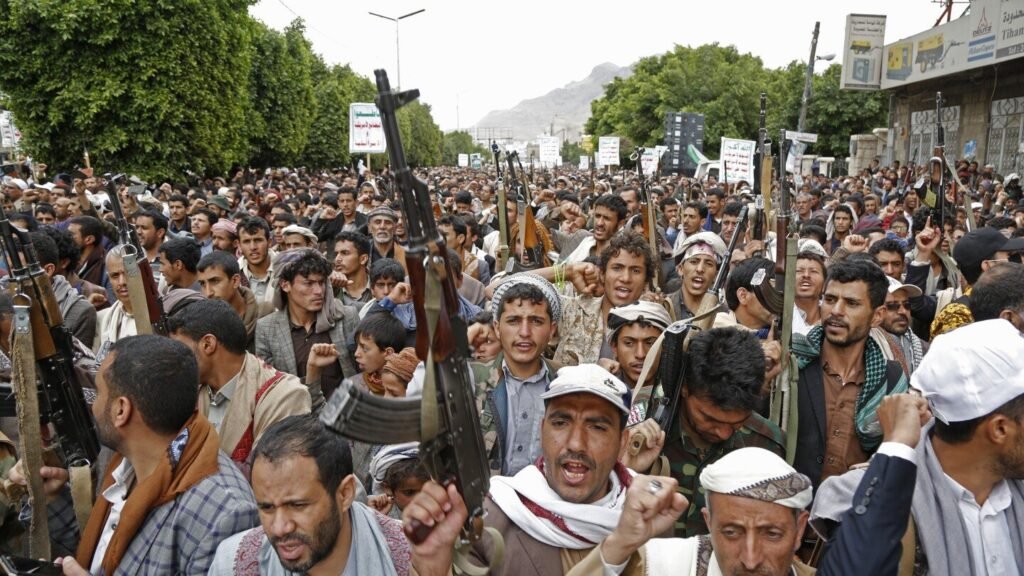WASHINGTON (news agencies) — When U.S. and U.K. warships and aircraft launched waves of missiles at Iranian-backed Houthi rebels in Yemen early Friday in Sanaa, it capped weeks of warnings to the militant group to cease their drone and missile attacks against commercial vessels in the Red Sea or face severe consequences.
Previously the U.S. had withheld striking back, reflecting larger U.S. concerns about upending the shaky truce in Yemen and triggering a wider conflict in the region. But on Tuesday the Houthis launched their largest-ever barrage of 18 one-way attack drones, anti-ship cruise missiles and an anti-ship ballistic missile at a host of international ships and warships in the Red Sea.
While the U.S. and partner military ships and aircraft protecting the waterways were able to deflect the attack, the scope and severity of the launch drew international condemnation and left few options other than to carry through with international warnings that any further attacks would draw a substantial response.
In response to the attacks Friday, which struck in Yemen just before 3 a.m. local time, the militant group has already pledged to retaliate.
Here’s a look at the Houthis and their increasing attacks, and why the U.S. believes it is more acceptable to bomb some Iranian-linked targets than others.
Houthi rebels swept down from their northern stronghold in Yemen and seized the capital, Sanaa, in 2014, launching a grinding war. A Saudi-led coalition intervened in 2015 to try to restore Yemen’s exiled, internationally recognized government to power.
Years of bloody, inconclusive fighting against the Saudi-led coalition settled into a stalemated proxy war between Saudi Arabia and Iran, causing widespread hunger and misery in Yemen, the Arab world’s poorest country. The war has killed more than 150,000 people, including fighters and civilians, and created one of the world’s worst humanitarian disasters, killing tens of thousands more.
A cease-fire that technically ended more than a year ago is still largely being honored. Saudi Arabia and the rebels have done some prisoner swaps, and a Houthi delegation was invited to high-level peace talks in Riyadh in September as part of a wider détente the kingdom has reached with Iran. While they reported “positive results,” there is still no permanent peace.
The Houthis have sporadically targeted ships in the region over time, but the attacks have increased since the start of the war between Israel and Hamas and spiked after an explosion Oct. 17 at a hospital in Gaza killed and injured many. That hospital blast marked the beginning of an intense militant campaign against U.S. bases in Iraq and Syria, and on many commercial vessels transiting the Red Sea. The attacks have damaged commercial ships and forced international shipping companies to divert their vessels around the Cape of Good Hope.
As of Thursday the Houthis had launched 27 different attacks on vessels transiting the Southern Red Sea, Pentagon spokesman Maj. Gen. Pat Ryder said at a Pentagon press conference.
Houthi military spokesman Brig. Gen. Yahya Saree has said the group wants to “prevent Israeli ships from navigating the Red Sea (and Gulf of Aden) until the Israeli aggression against our steadfast brothers in the Gaza Strip stops.”
But few of the ships targeted have had direct links to Israel. In a recent attack, one of the commercial ships hit — the Unity Explorer — had a tenuous Israeli link. It is owned by a British firm that includes Dan David Ungar, who lives in Israel, as one of its officers. Israeli media identified Ungar as being the son of Israeli shipping billionaire Abraham “Rami” Ungar. But any Israel connections to other ships are unclear.
U.S. officials have argued that the Houthis haven’t technically targeted U.S. military vessels or forces — a subtlety that Navy ship captains watching the incoming drones may question.
In response to the attacks, last month Defense Secretary Lloyd Austin announced Operation Prosperity Guardian, where the U.S. and more than 20 other countries have created a protective umbrella for the commercial vessels that have not rerouted.
If that operation had not been escorting the commercial vessels and intercepting the incoming fire, “we have no doubt that ships would have been struck, perhaps even sunk, including in one case a commercial ship full of jet fuel,” a senior administration official told reporters late Thursday, speaking on the condition of anonymity to discuss the strikes. “We’ve had extremely close calls.”
While the U.S. has carried out airstrikes on Iranian-backed militias in Iraq and Syria that have targeted American troops in 130 different attacks since Oct. 17, until Thursday the military had not yet retaliated against the Houthis.
That reluctance reflects political sensitivities and stems largely from broader Biden administration concerns about upending the shaky truce in Yemen and triggering a wider conflict in the region. The White House wants to preserve the truce and is wary of taking action that could open up another war front.
Iran-backed militias have launched one-way attack drones, rockets or close-range ballistic missiles at bases in Iraq 53 times and in Syria 77 times. Dozens of troops have suffered injuries as a result of the attacks, in many cases traumatic brain injuries.
In response, the U.S. has retaliated with airstrikes multiple times in Syria since Oct. 17, targeting weapons depots and other facilities linked directly to Iran’s Revolutionary Guard Corps and the militias. And it struck multiple sites in Iraq late last month after a militia group for the first time fired short-range ballistic missiles at U.S. forces at Al-Asad air base.
But until Thursday, striking the Houthis had been a different calculus.


